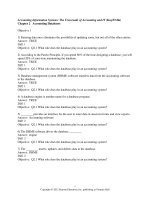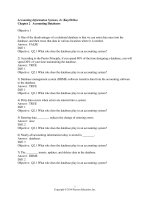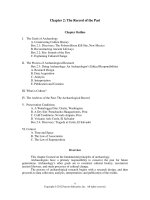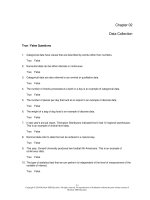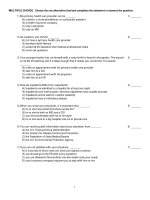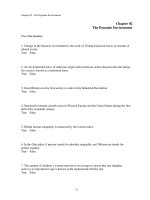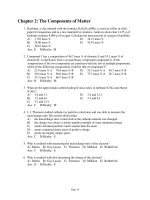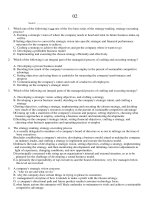Theories of psychotherapy and counseling concepts and cases 5th edition sharf test bank
Bạn đang xem bản rút gọn của tài liệu. Xem và tải ngay bản đầy đủ của tài liệu tại đây (722.94 KB, 25 trang )
Instructor's Manual for
THEORIES OF PSYCHOTHERAPY AND COUNSELING
CONCEPTS AND CASES
Fifth Edition
Richard S. Sharf
Brooks/Cole*Cengage Learning
Belmont, California
1
2012 Brooks/Cole, Cengage Learning
ALL RIGHTS RESERVED. No part of this work covered by the copyright hereon may be reproduced or
used in any form or by any means—graphic, electronic, or mechanical, including photocopying,
recording, taping, Web distribution, information storage and retrieval systems, or in any other manner—
except as may be permitted by the license terms herein.
ISBN-13: 9780840047595
ISBN-10: 0840047592
Cengage Learning
20 Davis Drive
Belmont, CA 94002-3098
USA
For product information and technology assistance,
contact us at:
Cengage Learning Customer & Sales Support
1-800-354-9706
For permission to use material from this text or product, submit a request online at
www.cengage.com/permissions.
Further permissions questions can be submitted by email to
2
PREFACE
This manual is designed to help instructors use the text, Theories of Psychotherapy and Counseling:
Concepts and Cases, Fifth Edition, in their course. I have included a chapter outline with discussion
questions and ideas, exam questions, a list of theories websites, and information about using Ed
Neukrug’s Theories in Action DVDs with this text.
I have included a chapter outline along with discussion questions to help instructors organize and
develop their class presentations. This outline can be edited to serve as course notes. Instructors may
wish to discuss specific cases described in the text with their class. Also, I have tried to select clienttherapist dialogues that can be read by pairs of students, so that they can "try on" various therapeutic
styles. For these reasons, it may prove helpful to ask students to bring their text to class. I have tried to
include discussion questions and ideas that will help students learn different perspectives on important
topics for various theories. Exercises and questions that relate to several parts of the chapter are
provided at the conclusion of the chapter outline.
I have created 657 multiple choice questions that you may select from in preparing examinations. In
this edition, I have added 10 new questions to most chapters and have removed 10 old ones. Some
original ones have been revised for clarity. I have tried to develop items of varying difficulty, and have
included questions that require recall, comparing, contrasting, or drawing inferences. I have included
page numbers from the text on which the correct answer can be found. For a few questions, there is no
specific page reference. For these, I indicate the correct answer with an *. I have provided a variety of
essay questions that can be used. Some are broad in nature; others are limited to specific constructs
which relate to one theory. I have written 10 sample questions for each chapter for students to use.
They can be found on the companion website, accessible through . These
questions are mainly taken from those which were removed from the previous list of exam questions.
I have created 252 PowerPoint slides along with a table of contents in the Outline section of PowerPoint.
New PowerPoint slides have been added for this edition. You may wish to select from the slides to
supplement your lectures. I have tried to provide a selection that represents each section of the 17
chapters in the text. These slides are available in the Instructor’s section of the book’s companion
website at />In Appendix A, there is a listing of websites that students may use to learn about specific theories. This
has been updated and greatly revised from the previous edition.
Appendix B gives information about how you might use the Theories in Action DVDs in teaching your
students. I include some general instructions as well as reproduce the questions for students and the list
of techniques used in the vignette. In the text these are boxed at the end of the chapter. The Theories in
Action DVDs are applicable to Chapters 2 through 12.
I welcome your questions or suggestions about this manual or the text. I can be emailed at
Richard S. Sharf
3
December 16, 2010
CONTENTS
PART ONE
Outline and Discussion
PART TWO
Multiple Choice Questions
5
81
Please note this online version of the Instructor’s Manual does not contain test items. To receive the
full Instructor’s Manual with Test Bank via email from eBank, please contact your Thomson sales
representative or the Academic Resource Center at 1-800-423-0563 or
PART THREE
Essay Questions
82
APPENDIX A
Theories Web Sites
96
APPENDIX B
Using the Theories in Action DVD
4
102
PART ONE
OUTLINE AND DISCUSSION QUESTIONS
I have provided an outline of each chapter with questions for discussion in order to help instructors
integrate their notes into the outline of the text or to serve as a basis for instructors to develop their
own notes. The chapter outlines are more detailed than those found in the Table of Contents of the
text. In this outline, titles that are in bold letters and all capitals refer to the major level of headings in
the book. For convenience, the page number of each major heading that is in the text is placed next to
the major level heading in this outline. Bold and lowercase letters are used for second level headings.
Third level headings are underlined. At the beginning of each chapter in this manual, I have included a
short paragraph that describes special issues that you may wish to consider in teaching the chapter.
After many of the headings, I have included some suggestions for topics for lectures as well as discussion
questions. The topics are presented as questions, but you may prefer to lecture on the topic instead of
asking the students the question. Rather than introduce a question, I just state it. Thus, rather than say
"Ask the students if they agree that the necessary and sufficient conditions of person-centered therapy
are truly necessary and sufficient? Why?", I just say "Do you agree that the necessary and sufficient
conditions of person-centered therapy are truly necessary and sufficient? Why?" Some questions are
asked in "yes" or "no" form with an implicit or explicit request to explain further. At the end of each
chapter in this manual, I have included a section called ”Classroom Exercises.” This section includes
both questions and exercises that are more general or global in nature than questions related to specific
chapter sections.
Although some of these suggestions may be helpful, others may be less relevant for your purposes.
Because this manual is electronic rather than paper, you can edit the course outline that I have provided
in a way that suits your own purposes. Some of the questions that I have included ask students about
their lives and may or may not be appropriate for certain classes. Sometimes it may be helpful to have
students bring their textbooks to class so that they may try out the dialogues with one another, with one
student playing the therapist and the other the client. This will work only if students take the dialogue
seriously, respecting the therapist and the client. Demonstrating theoretical approaches to students
and having them role-play can be helpful. Choosing to make use of demonstration and role-playing are
a function of instructor familiarity and comfort, as well as the students' prior training. Some theories,
like Jungian analysis, may be almost impossible to role-play, whereas other approaches, such as personcentered therapy and cognitive therapy, lend themselves more easily to role-play.
I include two Appendices. Appendix A lists websites for each chapter. They include associations for the
theories in the text. Appendix B gives information about how you might use the Theories in Action DVDs
in teaching your students. I include some general instructions as well as reproduce the questions for
students and the list of techniques used in the vignette. In the text these are boxed at the end of the
chapter. The Theories in Action DVDs are applicable to Chapters 2 through 12.
5
CHAPTER 1
INTRODUCTION
This chapter can prove helpful in giving students an overview of the theories that are discussed and the
rationale for the information that describes each theory. Spending time to go over common
psychological disorders discussed in the text can be useful as the terms are used in many of the
chapters. New to this edition of the text is a discussion of research-supported therapies. Describing
difficulties involved for therapists in using research-supported therapies in practice may be helpful. (The
common factors approach is described in more detail in Chapter 16.)
THEORY (2)
What would you look for in a theory? What theories have you studied in other disciplines? What types
of information do those theories provide? What kind of information do you want from a theory that will
guide you in helping others? Are there criteria besides those listed below that would be helpful?
Precision and clarity
Comprehensiveness
Testability
Usefulness
PSYCHOTHERAPY AND COUNSELING (4)
Do you agree with the author's definition of counseling and psychotherapy? How might you change it?
Although the author may use counseling and psychotherapy interchangeably, would you? What
meaning do the terms ”patient“ and ”client“ have for you? What characteristics would you regard as
important in a therapist if you were seeking therapy?
THEORIES OF PSYCHOTHERAPY AND COUNSELING (5)
How is it possible for therapists to develop over 400 theories of therapy? It may be helpful to the class
to summarize major characteristics of the theories to be described in the course. Discussing the
unconscious, feelings, behaviors, and thoughts as major areas of emphasis that discriminate among
theories may be useful. Possibly point out that returning to the summaries on pages 6 through 9 can
help students if they need an overview of a theory, as can the summaries of important concepts that are
listed in Chapter 16.
Psychoanalysis
Jungian analysis and therapy
Adlerian therapy
6
Existential therapy
Person centered therapy
Gestalt therapy
Behavior therapy
Rational emotive behavior therapy
Cognitive therapy
Reality therapy
Constructivist approaches
Feminist therapy
Family therapy
Other psychotherapies
Integrative therapies
ORGANIZATION OF THE CHAPTERS (10)
The text is written so that each of the major sections: history or background, personality theories,
theory of psychotherapy, and psychological disorders, follow each other sequentially and provide
material to help the student further understand the theory. I do not assume that students have had any
previous course work related to psychotherapy or counseling. However, students who have had a
Theories of Personality course will find it particularly helpful in learning or reviewing concepts described
in the Personality Theories section. Those students who have had an Abnormal Psychology course
should find that the Psychological Disorders section flows quite easily. Child or Adolescent Development
courses also will be useful in understanding those theories that use a developmental approach to
personality. In the Research section, I give only an overview of research methodology. Some instructors
may prefer to omit the Research sections throughout the book; others may wish to assign other
readings to augment the methodological discussion described here.
History or background
Personality theories
Theory of psychotherapy
Goals, assessment, and techniques are important in theories of psychotherapy. What other information
do you want a theory of psychotherapy to provide?
Psychological disorders
Illustrating the psychological disorders described in this section can be helpful. Case examples or
7
examples from the students' own lives can be useful.
Depression. When you are depressed, how do you think, feel, and behave? How is severe
depression different from a depressed feeling?
Generalized anxiety disorder. When you are anxious, how do you think, feel, and behave? How
is a severe anxiety disorder different from moderate anxiety?
Borderline disorder. What is it like to relate to someone who seems emotionally unstable? If
you feel that way sometimes, what is it like?
Obsessive-compulsive disorder. How are obsessions different than compulsions? What is it like
to have a constantly reoccurring thought?
Phobias. How is a phobia different from a rational fear?
Somatoform disorder. How can you discriminate a real illness from a somatoform disorder?
What is meant by hysteria?
Posttraumatic stress disorder. How could you have a posttraumatic stress reaction to being
assaulted or being in a war? How would your thoughts, feelings, and behaviors be different
than they are now?
Eating disorders. What are societal pressures about eating? What would cause you to stop
eating or to vomit what you had just eaten? How can an anorexic person have a distorted body
image?
Substance abuse. How have you experienced substance abuse in your life, either directly or
indirectly? How have you seen substance abuse affect the lives of people you know?
Narcissistic personality disorder. If you were narcissistic, how would you be different? How do
you feel when you talk to a person who behaves narcissistically?
Schizophrenia. What is it like to talk to someone who has schizophrenia? What would it be like
to grow up in a household where one parent had schizophrenia?
Brief psychotherapy
If you were seeking therapy, how long would you expect it to take? How would you feel about a brief
approach?
Current trends and innovations
What are the advantages and disadvantages of treatment manuals? What type of therapies can most
easily become research-supported therapies? How does postmodernism differ from modernism? How
can a constructivist and a theoretical point of view be compatible?
Treatment manuals
Research-supported psychological treatments
Postmodernism and constructivism
Using a theory with other theories
What are the pros and cons of using only one theory?
Research
For students to have an overview of how research on psychotherapy is done, it might be helpful to
review concepts, such as pretest-posttest design, control group, and meta-analysis. An overview of how
an outcome study is designed with reference to participant, therapist, and problem selection may help,
as will a discussion of criteria for therapeutic change and the need for follow-up at varying time periods.
In this book, I present only brief explanations of research. A minimal understanding of research
8
methodology is needed for students to understand the research discussion.
Gender issues
Although the different ways that men and women experience the world is described in detail in Chapter
13, Feminist Therapy: A Multicultural Approach, it may be helpful for students to consider how gender
differences can affect the therapeutic experience.
Multicultural issues
Chapter 13, more than other chapters, describes treatment methods for dealing with cultural issues. A
discussion of how cultural issues are related to a theory of psychotherapy, and affect a therapist's way
of responding, and a patient's way of presenting a problem, may be helpful.
Group therapy
How would you approach group therapy as opposed to individual therapy? What are the advantages
and disadvantages of group therapy?
ETHICS (23)
I only deal briefly with ethics. Often this subject is taught in other courses. Making available the ethical
code of the professional group that is most relevant for your students is helpful, if you wish to cover the
subject thoroughly.
MY THEORY OF PSYCHOTHERAPY AND COUNSELING (24)
Discussing your own approach to therapy, how you developed it, and how students may develop theirs
might be useful.
YOUR THEORY OF PSYCHOTHERAPY AND COUNSELING (24)
How will you decide which theories of therapy are most appropriate for you?
CLASSROOM EXERCISES
1.
Divide students into small groups to argue differences versus no differences between
psychotherapy and counseling.
2.
What characteristics would students look for in a therapist?
3.
In what ways is it helpful and in what ways is it not helpful to use a classification system of
psychological disorders for assessment in therapy?
4.
Would you want to use research-supported psychological treatments if you were a therapist? Why
or why not?
5.
In learning to do therapy, would you prefer to use a treatment manual or not? Divide students
into small groups to debate this issue.
6.
Have students contrast the advantages and disadvantages of individual, group, and family therapy.
9
EXAM QUESTIONS FOR
THEORIES OF PSYCHOTHERAPY AND COUNSELING: CONCEPTS AND CASES
FIFTH EDITON, RICHARD S. SHARF
Most of the multiple choice questions are about important concepts and their application. I have tried to vary the
type of question and difficulty level. I have included a very few questions about details of cases described in the
text. The numbers next to the answer indicate that it is the correct answer and show on what page of the text it can
be found. A few correct answers have no specific page reference and correct answers are indicated with an *.
Instructors may wish to change the order in which the questions are presented, as the order sometimes gives a clue to
the correct answer. Typically, I have listed them in the order that they occur in the text. Questions comparing one
theory to another will be found throughout. However, questions from Chapter 16 include only questions that
compare one theory with another. Perhaps the best instructions are: Please choose the best answer from the choices
that are given. Students may view practice questions on the Cengage*Brooks/Cole website for students. There are
10 questions for each chapter. None will be repeats of these questions.
Please remember to delete the page numbers when creating a test!
CHAPTER 1
INTRODUCTION
1.
Theories of any type should be based on
a.clear rules. (2)
b.
many assumptions.
c.a unique plan.
d.
unrelated laws or relationships.
2.
The term "counseling"
a.does not differ consistently from "psychotherapy". (4)
b.
is used to differentiate types of mental health professionals.
c.refers to helping people with educational and vocational concerns.
d.
refers to helping people with normal problems.
3.
The term "psychotherapy"
a.does not differ consistently from "counseling". (4)
b.
is used to differentiate types of mental health professionals.
c.refers to helping people with educational and vocational concerns.
d.
refers to helping people with normal problems
4.
The most commonly identified approach to psychotherapy is
a.behavioral.
b.
cognitive.
c.integrative. (4)
d.
psychoanalytic/psychodynamic.
5.
Which of these statements is a factor common to all therapies?
a.The relationship between client and therapist is important for progress. (10)
b.
The therapist should be integrative.
c.The therapist should be trained in psychoanalysis.
d.
The therapist should be able to give good advice.
10
6.
An individual who is very talkative and distractible may be exhibiting behavior best described as
a.anxious.
b.
compulsive.
c.manic. (13)
d.
unpredictable.
7.
Mary has difficulty getting up in the morning and has little desire to do her school work. This could be an
indication of
a.borderline personality disorder.
b.
depression. (13)
c.generalized anxiety disorder.
d.
a phobia.
8.
Abigail has had several brief romantic relationships, all ending in disappointment as she has felt that her
lovers did not live up to her expectations. This is most likely an indication of a (an)
a.borderline personality disorder. (14)
b.
depression.
c.generalized anxiety disorder.
d.
obsessive-compulsive disorder.
9.
A re-occurring thought that one will die at the age of 46 is an example of
a.anxiety.
b.
compulsions.
c.phobias.
d.
obsessions. (14)
10.
When headaches can not be traced to any known physiological cause they may be most likely symptoms of
a.anxiety disorder.
b.
conversion reaction.
c.posttraumatic stress disorder.
d.
somatoform disorder. (15)
11.
John feels that people at work should appreciate him and realize he is the reason his company is successful,
although he has little concern about his fellow employees and their problems.. This may be a symptom of
a(an)
a.borderline personality disorder.
b.
phobia.
c.narcissistic personality disorder. (15)
d.
somatoform disorder.
12.
Belinda hears the voice of William Shakespeare communicating with her about her writing. She may be
suffering from
a.an anxiety disorder.
b.
a borderline disorder.
11
c.neurosis.
d.
schizophrenia. (16)
13.
Kalinda has been eating 300 calories of food per day for the past year. She is suffering from:
a.anorexia. (15)
b.
bulimia.
c.a somatoform disorder.
d.
posttraumatic stress.
14.
Which of these statements best describes research supported psychological treatments? Research supported
psychological treatments refer to therapies that
a.are based on treatments supported by scientific investigation. (18)
b.
are multicultural in their approach.
c.are recommended by all theories of therapy.
d.
uncover the unconscious.
15.
Research supported psychological treatments
a.are based on studies of the effectiveness of psychotherapy. (18)
b.
are multicultural in their approach.
c.are only used by cognitive and behavioral therapists.
d.
are only used with individuals with phobias.
16.
The position that there is a fixed truth rather than perceptions of reality or truth is associated with
a.constructivism.
b.
modernism. (19)
c.postmodernism.
d.
social constructivism.
17.
Focusing on the perceptions of the client rather than the therapist's view of the problem is most consistent
with
a.constructivism. (19)
b.
modernism.
c.feminism.
d.
colonialism.
18.
A researcher studies a group of depressed patients for 5 years to determine the effectiveness of therapy. Her
research can be criticized for failing to
a.define the group to be studied.
b.
do a follow up study.
c.have a control group. (21)
d.
perform a meta-analysis.
19.
Ethical codes should be
a.irrelevant to the practice of psychotherapy theory.
12
b.
different for different psychotherapy theorists.
c.followed in the practice of theories of psychotherapy. (23)
d.
identical across all mental health professions.
20.
Ethical codes apply
a.only to psychoanalytic therapies.
b.
only to behavior therapies.
c.only to humanist therapies.
d.
to all therapies. (23)
CHAPTER 2
PSYCHOANALYSIS
21.
Freud's university training was in
a.medicine. (30)
b.
philosophy.
c.English.
d.
theology.
22.
Freud's first work in psychiatry was with patients suffering from
a.anxiety disorders.
b.
borderline disorders.
c.hysterical disorders. (31)
d.
narcissistic disorders.
23.
Thanatos refers not only to an instinct for death, but also to
a.aggressive drives. (33)
b.
actualizing drives.
c.sexual drives.
d.
unconscious drives.
24.
According to Freud, events that can be remembered with some effort, but not immediately, arise from the
a.collective unconscious.
b.
conscious.
c.preconscious. (33)
d.
unconscious.
25.
According to Freud, forgotten memories that are frightening are likely to be found in the
a.conscious.
b.
preconscious.
c.unconscious. (34)
d.
countertransference.
26.
Interpretation of dream material allows the psychoanalyst to
a.bring unconscious material into conscious awareness. (34)
b.
bring unconscious material into the preconscious.
13
c.explore the unconscious.
d.
explore the preconscious.
27.
At birth the infant is all
a.false self.
b.
id. (34)
c.superego.
d.
all of the above.
28.
Which of the following is identified with the id?
a.identity
b.
conscious
c.preconscious
d.
unconscious (34)
14
29.
Anticathexis refers to the
a.ego's control over the id. (35)
b.
ego's control over the superego.
c.superego's control over the ego.
d.
superego's control over the false self.
30.
When Barbara follows her parents' example in being kind to her baby sister, the following is being formed:
a.ego.
b.
ego ideal (35).
c.id.
d.
superego.
31.
According to Freud, Ben, who is angry at his brother and is afraid that he might push him into a busy
highway, is demonstrating
a.generalized anxiety.
b.
moral anxiety.
c.neurotic anxiety. (35)
d.
reality anxiety.
32.
If Bernice can't remember being sexually abused as a child, she may be using the defense mechanism called
a.projection.
b.
reaction formation.
c.rationalization
d.
repression. (36)
33.
Picked on constantly at school, Bruce would come home and throw his cat against the wall, thus
____________ his anger. Pick the appropriate psychoanalytic term.
a.tantruming
b.
displacing (36)
c.intellectualizing
d.
repressing
34.
Bill, a 7 year-old boy, wears a football jacket with the logo of his favorite football team to school every day,
and feels bigger and stronger because of this. Bill is illustrating the defense mechanism of
a.identification. (37)
b.
intellectualization.
c.regression.
d.
repression.
35.
During his first day of kindergarten, Basil curls up into a ball, cries, and sucks his thumb, illustrating
a.denial.
b.
reaction formation.
c.regression. (33)
15
d.
repression.
36.
Carla explains patiently to her boy friend why they should continue to see each other despite his continual
angry protest about her dating other men. Her feelings for him are becoming weaker, yet she tells him that
she believes in the philosophy of freed
a.identification.
b.
intellectualization. (37)
c.reaction formation.
d.
regression.
37.
The stage of development in which children develop the most bodily control is the
a.anal stage. (38)
b.
genital stage.
c.oral stage.
d.
phallic stage.
38.
The earliest stage of development is the
a.anal stage.
b.
genital stage.
c.phallic stage.
d.
oral stage. (37)
39.
The focus of sexual energy toward others rather than oneself occurs in the
a.anal stage.
b.
latency stage.
c.oral stage.
d.
genital stage. (38)
40.
The significance of the oral, anal, phallic, latency, and genital stages is that they
a.are important to all psychoanalysts.
b.
occur in no specific sequence.
c.refer to specific psychological disorders.
d.
represent the importance of biological drives in determining personality. (38)
16
41.
Anna Freud's concept of developmental lines refers to the gradual development of the
a.ego. (39)
b.
genital stage.
c.id.
d.
superego.
42.
Which one of the following is considered an ego psychologist?
a.Donald Winnicott.
b.
Erik Erikson (39)
c.Carl Jung
d.
Sigmund Freud
43.
According to Erik Erikson the development of trust in an individual begins in Freud's
a.anal stage.
b.
genital stage.
c.oral stage. (39)
d.
phallic stage.
44.
A key stage for Erik Erikson that takes place in adolescence is
a.identity versus role confusion. (39)
b.
industry versus despair.
c.integrity versus guilt.
d.
intimacy versus isolation.
45.
Erikson's stage of trust vs. mistrust corresponds with one of Freud's stages?
a.anal stage
b.
genital stage
c.oral stage (40)
d.
phallic stage
46.
Object relations theorists focus on how individuals
a.deal with id impulses.
b.
handle id-ego conflict.
c.separate from their mothers and become independent persons. (41)
d.
develop the bipolar self.
47.
Vivian, due to her mother's excellent child-raising, gradually becomes a self sufficient, independent person.
This observation is most likely to be made by which of these schools of psychoanalysis?
a.drive theory
b.
ego psychology
c.object relations (41)
d.
self psychology
17
48.
Barry, 8-years-old, acts in age appropriate ways, not as his mother demands. According to Donald
Winnicott, he is developing his
a.false self.
b.
true self. (42)
c.superiority complex.
d.
super ego.
49.
According to Donald Winnicott, when children act as they are expected to by others, rather than act as they
want, then they may develop
a.a false self. (42)
b.
a true self.
c.an inferiority complex.
d.
separation anxiety.
50.
Donald Winnicott believes that in early infancy, infants must have their needs met by their mother, but later
they must be helped by their mother to develop independence. This concept is called
a.good-enough mothering. (42)
b.
hatching.
c.authenticity.
d.
separation.
51.
According to Donald Winnicott, an object that can help children make the transition from a subjective view
of self to being a person in the world, is
a.a bottle.
b.
a sibling.
c.a teddy bear. (42)
d.
a therapist.
52.
Object relations theorists focus on psychological problems that occur in the individual __________
adolescence.
a.prior to (42)
b.
at the same time as
c.after
d.
because of
53.
As defined by Otto Kernberg, splitting refers to
a.keeping early memories outside of consciousness.
b.
keeping incompatible feelings separate from each other. (43)
c.the gradual separation of the personality into two parts.
d.
the sudden emergence of traumatic memories into consciousness.
54.
The tension between not getting what you want and believing that your parents are wonderful is associated
with the work of
a.Anna Freud.
18
b.
Donald Winnicott.
c.Heinz Kohut. (44)
d.
Sigmund Freud.
55.
The tension between not getting what you want and believing that your parents are wonderful is called
a.splitting.
b.
the bipolar self. (44)
c.the selfobject.
d.
transmuting internalizations.
56.
According to Heinz Kohut, the motivating organizer of development is
a.splitting.
b.
the collective unconscious.
c.the superego.
d.
narcissism. (44)
57.
For Kohut, mirroring supports
a.the development of the superego.
b.
the grandiose self. (44)
c.the identity stage.
d.
the separation and individuation process.
58.
The concepts of id, ego, and superego were LEAST important for
a.Anna Freud.
b.
Donald Winnicott.
c.Heinz Kohut. (45)
d.
Sigmund Freud.
59.
A focus on intersubjectivity, the concept that both psychoanalyst and patient influence each other, is most
closely identified with
a.drive theory.
b.
ego psychology.
c.object relations.
d.
relational psychoanalysis. (45)
60.
The concept of two-person psychology is most likely to be associated with
a.drive theory.
b.
ego psychology.
c.object relations.
d.
relational psychoanalysis. (45)
61.
Psychoanalysis can help patients get better by helping them to
a.Resolve unconscious conflicts within themselves. (46)
b.
change their beliefs to change behavior.
19
c.learn about their regression.
d.
understand their id.
62.
For psychoanalysts of all types, a significant therapeutic goal for patients is
a.free association.
b.
resolving conflicts within themselves. (47)
c.understanding the separation and individuation process.
d.
understanding splitting.
63.
Adapting in positive ways to the external world, is a therapeutic goal associated with
a.ego psychology. (47)
b.
Freudian drive theory.
c.object relations.
d.
self psychology.
64.
Traditional psychoanalysis and psychoanalytic therapy are similar in that they both
a.explore the impact of early childhood development. (48)
b.
have meetings 4 times a week with the patient.
c.rely on free association as a primary technique.
d.
use a couch.
20
65.
Which of these forms of therapy is likely to be most expensive for the patient
a.behavior therapy.
b.
cognitive therapy.
c.psychoanalysis. (49)
d.
psychoanalytic psychotherapy.
66.
In psychoanalysis, forgetting appointments is an example of
a.free association.
b.
regression.
c.resistance. (50)
d.
separation.
67.
In psychoanalysis, the symbolic content of a dream refers to its
a.archetypal content interpretations about archetypes.
b.
latent content, symbolic and unconscious motives in the dream. (51)
c.manifest content, the dreams as the dreamer sees it.
d.
existential content.
68.
Charlene, having been ignored by her father when she was a small child, also feels angry at her
psychoanalyst, whom she believes is ignoring her. This is an example of
a.countertransference.
b.
repression.
c.interpretation.
d.
transference. (53)
69.
Identifying irrational feelings in the psychoanalytic therapist as they relate to the patient is associated with
the concept of
a.countertransference. (54)
b.
denial.
c.the superego.
d.
transference.
70.
Otto Kernberg's term, transference psychosis, refers to the patient's behavior toward the therapist that reflects
a.behavior towards the therapist that includes unclear speech and description of hallucinations.
b.
behavior towards friends and family that includes unclear speech and description of hallucinations.
c.the destructive relationship the patient had with parents. (53)
d.
free associations that are incoherent and non-productive.
71.
When being empathic, Heinz Kohut focuses on his patient's
a.concern about relationship's with friends or family.
b.
early difficulties with self and others. (49)
c.experiences in the session.
d.
separation from the family.
21
72.
Focusing on the developing interaction between mother and child is an indication that the therapist is using
the point of view derived from
a.Freudian drive theory.
b.
object relations.(41)
c.self psychology.
d.
relational psychoanalysis.
73.
Focus on conflictual relationship in short term psychodynamic therapy has been the work of
a.Anna Freud.
b.
Kohut.
c.Luborsky. (63)
d.
Sigmund Freud.
74.
"It seems to me that you want to be in a relationship where . . . " is a statement that is most likely to be made
by a psychodynamic therapist using
a.Freud's drive theory.
b.
ego psychology.
c.Luborsky's Core Conflictual Relationship Theme method. (63)
d.
self psychology.
75.
Relationship Episodes are likely to be used in psychodynamic therapy when _______________ is applied.
a.Freud's drive theory
b.
ego psychology
c.Luborsky's Core Conflictual Relationships Theme method (63)
d.
self psychology
76.
Treatment manuals are used in the application of _________ to psychoanalytic therapy.
a.ego psychology
b.
Freudian drive theory
c.Luborsky's Core Conflictual Relationship Theme method (66)
d.
object relations psychology
22
77.
In psychoanalysis constructivism has had a major influence on a
a.one person psychology.
b.
two person psychology. (66)
c.three person psychology.
d.
five person psychology.
78.
In a long term study of psychoanalysis, Wallerstein reported that an important reason for therapeutic change
in psychoanalysis was
a.insight brought about by therapist interpretation of unconscious material
b.
insight brought about by therapist interpretation of counter transference issues
c.the release of repressed material into consciousness
d.
willingness to change to please the therapist (68)
79.
The development of specific measurement instruments by psychoanalytic researchers help provides
a.answers to whether or not psychoanalysis is superior to other therapies
b.
answers to whether or not psychoanalysis is superior to psychoanalytic psychotherapies
c.explanations for positive change in psychoanalytic or psychodynamic treatment (69)
d.
explanations for the impact of splitting on psychotherapeutic change.
80.
Attachment theory studies concepts that are most similar to concepts in
a.ego psychology.
b.
Freudian drive theory.
c.object relations. (70)
d.
self psychology.
81.
Brief psychoanalytic therapy is typically this length.
a.1-5 sessions
b.
12-40 sessions (63)
c.35-125 sessions
d.
75-225 sessions
82.
Ainsworth identified 3 patterns of attachment in young children. Which of these is NOT a pattern of
attachment?
a.ambivalent
b.
individuation (70)
c.avoidant
d.
secure
83.
The theory that has been subject to the most criticism for its treatment of the psychological development of
women has been
a.behavior therapy.
b.
gestalt therapy.
c.Jungian therapy.
23
d.
psychoanalytic therapy. (71)
84.
Chodorow and some other critics of the psychoanalytic treatment of women's development suggest that
object relations theorists should focus on
a.child-mother relationships.
b.
child-parent relationships. (72)
c.penis envy.
d.
womb envy.
85.
The psychoanalytic theorist who was most interested in multicultural issues was
a.Donald Winnicott.
b.
Erik Erikson. (72)
c.Heinz Kohut.
d.
Sigmund Freud.
86.
As an example of recent work in multicultural issues as they affect psychoanalysts, researchers have studied
a.the effect of the shadow archetype on psychoanalysis.
b.
inferiority and superiority in self-esteem across cultures.
c.how skin color can effect the transference relationship. (72)
d.
meaningfulness in life as it applies to different cultures.
87.
Psychoanalysis can be criticized because of
a.a tendency to make broad generalizations about women. (71)
b.
its recent failure to reach out to diverse populations.
c.its failure to attend to early childhood development.
d.
its tendency to ignore group approaches to therapy.
88.
After six years of three times a week psychoanalytical therapy, Ellen becomes silent and less cooperative
with her analyst than she had been before. Her analyst would most likely focus on her
a.ego.
b.
grandiose self.
c.regression.
d.
resistance. (50)
24
89.
A major goal of psychoanalysis is
a.behavioral change.
b.
improved marital relationships.
c.parental reconciliation.
d.
self understanding. (47)
90.
Harvey got angry at his psychoanalyst for no apparent reason. This is most likely and example of
a.empathy.
b.
countertransference.
c.transference.(53)
d.
interpretation.
91.
Examining how a patient's dream relates to a current problem would be called _______________ in
psychoanalysis.
a.countertransference
b.
transference
c.interpretation (51)
d.
a relational response
92.
In psychoanalytic group therapy, some group leaders emphasize making interpretive comments about
a.efforts by group members to achieve target behaviors.
b.
empathic relationships within the group.
c.resistances and transference. (73)
d.
the group as a family system.
25
